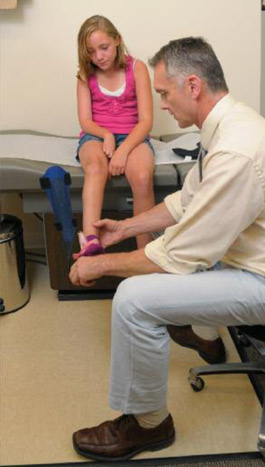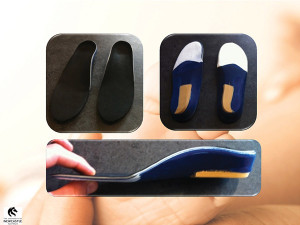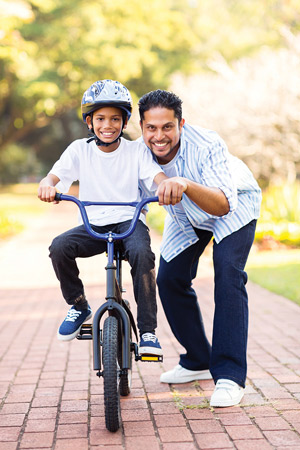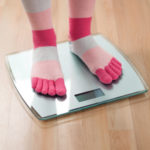
Photo by Vincent Giordano/Trinacria Photography (trinacriaphotography.com), courtesy of Clinical Prosthetics & Orthotics.
Juvenile idiopathic arthritis (JIA) affects nearly a quarter of a million US kids younger than 16 years. The hallmarks of the autoimmune disorder include joint inflammation, stiffening, and damage, as well as changes in joint growth, all of which can prove painful.
By Shalmali Pal
JIA is the most common form of arthritis among US children. There are three general types of the disorder:1 Oliogoarticular, in which just a few joints are affected, most notably in the knee or the ankle; polyarticular, in which five or more small joints are affected, most often in the feet and hands; and systemic, in which there is swelling, pain, and limited motion in at least one joint, along with other symptoms such as skin rash and inflammation of the internal organs.
Children with JIA often present with a long-term limp that can’t be explained by other causes, such as an injury. They may also have myriad of ankle and foot deformities (pes planovalgus, for example). If left untreated, these biomechanical limitations can cause long-term joint destruction and limit mobility and function.2
Children with JIA develop muscle spasm in an effort to limit their joint mobility, says Paul Scherer, DPM, founder and chief executive officer of ProLab Orthotics in Napa, CA. He noted, for example, that children with JIA commonly have fusion of the subtalar joints.3 “There are three facets in the subtalar joints,” he said. “If one of these facets does not form properly, it becomes arthritic. It then hurts for these kids to move the facets in the joint. Orthotic devices can help maintain stability of an arthritic joint in children [with JIA] so that the muscle spasm as a physiologic response is unnecessary.”
JIA can result in a number of gait abnormalities.
In a 2010 study from Germany, adolescents with JIA (average age 13.2 years) underwent gait analysis, and investigators compared their results with healthy controls.4 According to the authors, those with JIA showed reduced walking speed and step length, strongly anterior tilted pelvis, reduced maximum hip extension, reduced knee extension during single support phase, and reduced plantar flexion in push off.

Figure 1. An example of one adjusted orthosis from Coda’s trial. Investigators used high-density EVA to create an antipronatory correction at the rearfoot and added a kinetic wedge at the first metatarsal head and shock absorption materials. (Photo courtesy of Andrea Coda, PhD.)
Also, the foot’s roll-off was decelerated, and there were lower peaks in ankle movement and power. “The gait of JIA patients can be explained as a crouch-like gait with hyperflexion in the hip and knee joints and less plantar flexion in the ankle,” the authors wrote.4
Unfortunately, JIA management and treatment guidelines offer little help with regard to gait abnormalities and orthotic devices. The American College of Rheumatology’s 2013 update to its treatment recommendations doesn’t cover foot health and gait; neither do 2013 guidelines from the Children’s Arthritis and Rheumatology Research Alliance.5,6 Other organizations, such as Australia’s National Health and Medical Research Council, discuss orthoses in their JIA management guidelines, but give podiatric interventions a “D” grade (indicating weak evidence for their use) and note clinicians should consider the use of foot orthoses on an individual basis.7
LER: Pediatrics checked in with experts on how to manage lower limb pathologies with orthotic devices, physical therapy, and exercise. They also discussed when lower extremity professionals should be called in to work with children with JIA.
Pain and devices
Orthoses can’t address the characteristic joint inflammation of JIA, but they can help reduce pain and prevent ongoing damage to those compromised joints, said Mary Powell, RPT, of PT in Motion in San Diego, CA. Back in 2005, while Powell was at the Children’s Hospital and Health Center in San Diego, she led one of the first trials that compared the clinical efficacy of custom foot orthoses, prefabricated devices, and supportive athletic shoes alone for reducing pain and improving function in 40 children with JIA.
Her group reported that, at three-month follow-up, those who received custom-made orthoses showed significantly greater improvements in foot pain, overall pain, speed of ambulation, limitations on activity, and level of disability compared with children in the other study arms.8 An impetus for Powell to do the study was to find an alternative to the UCBL (University of California Biomechanics Laboratory) orthoses that patients with JIA were being prescribed at the time to manage lower extremity malfunction.
“I wanted to see if we could get the kids out of the UCBLs because they weren’t wearing them—they were too rigid, too high, too stiff, and it was difficult to find shoes to accommodate them,” she explained.
In a 2014 study, a group led by Andrea Coda, PhD, a lecturer at the University of Newcastle in Ourimbah, Australia, compared prefabricated fitted foot orthoses customized with “chair-side corrections” with the same orthoses without corrections in 60 children with JIA (study group: n = 31, mean age, 10.64 years; control group: n = 29, mean age, 11.17 years).9
The study group received foot orthoses adjusted for a better fit based on each patient’s particular deformity, while the control group got the device as manufactured: a 1-mm leather board with a .75-mm black ethylene vinyl acetate (EVA) cover. All participants experienced a statistically significant reduction in pain measured with a visual analog scale from baseline to six months, with the adjusted orthoses group reporting greater improvement in both pain and in quality of life.9
Coda noted that the children completed 179 out of 180 assessments at various time points during the six-month study period, which speaks to the success of the corrected and uncorrected devices. “For a randomized, controlled trial, that kind of compliance is rare,” Coda pointed out. “To me, this showed that the children welcomed the intervention…the fact that they were happy to come back, as were the parents to have the children assessed, at baseline, three months, and six months.”
Coda and colleagues developed and implemented chair-side corrections (Figure 1) for the fitted orthoses in the study based on their clinical experience. The corrections, he said, are those “podiatrists are comfortable making in their daily practice.” Adjustments were based on results from walkway-based gait analysis and in-shoe sensors that measured force data, plantar pressure, and temporal and spatial parameters.
These adjustments included, but weren’t limited to: additions to varus rearfoot to prevent excessive pronation as well as the addition of antipronatory corrections at the rearfoot; heel raises to address anatomical leg length discrepancies; and metatarsal pads and cushioning top covers to deflect plantar pressure and provide shock absorption to reduce peak pressure and pressure time integral in areas of active arthritis.
Powell said she reserves rigid orthoses for patients with hypermobile feet who need maximum control and stability. Her preference is for a semiflexible material. “It has a shell that doesn’t completely collapse, and more spring for shock absorption. Then I’ll customize it with padding where it’s needed—arch support, metatarsal pads, heel pads.”
In terms of creating her custom devices, Powell said she uses a nonweightbearing cast that holds the patient in subtalar neutral. One of the main goals with the orthoses is to “achieve a more optimal alignment,” she explained. Devices are then customized depending on the patient’s needs, such as taking pressure off areas where there is joint inflammation.
“Then I will ‘unweight’ tender parts of the foot and distribute the weight across a bigger area of the foot,” she said. “With that weight distribution comes less pain, less deformity, and fewer abnormal gait patterns. Also, when the weight is distributed and more shock is absorbed across the foot, patients ultimately can walk longer, faster, and participate more in life.”
Powell cautioned that not every patient with JIA needs orthoses. “If they are not in a great deal of pain, and are reasonably mobile, then a supportive athletic shoe may be enough, or a shoe with an orthosis that offers padding or shock absorption. I don’t want to give them more than they need,” she said.
From a financial perspective, prescribing more than a child needs can be costly. Scherer noted that children outgrow custom-made orthoses fairly quickly. “A custom-made orthotic is really only custom for a year,” he said. “The child’s foot will get bigger, it’ll get wider, it’ll change shape.” Prefabricated devices are a suitable alternative, but Scherer cautioned that practitioners need to consider the sizing.
“Select a prefab device with a very small gradient of change. One device may say it fits a toddler three to a toddler nine [shoe size], but that’s a huge range,” he said. “Would something that fits a toddler one to five be better? Usually, you can find prefab devices for children that are made with one-year size gradients.”
Encouraging exercise
When it comes to physical activity, children with JIA are in a bit of a catch-22. There is mounting evidence that these children can improve their physical fitness and function, with no increase in disease activity, through physical activity. Pediatricians now recommend that, in general, children with JIA get the same amount of physical activity as healthy children—60 minutes of moderate to vigorous activity a day.10 However, even if their disease activity is controlled with medications, these kids may still have pain and functional limitations, along with impairments in aerobic fitness and muscle strength, compared with typical children.11
Fortunately, the use of foot orthoses can improve ambulation and movement, potentially making it easier for children to be active. As part of their study, Coda’s group looked at secondary outcomes of gait, both with and without orthoses. They reported significant improvements with fitted orthoses in gait time (seconds), gait velocity (cm/second), plantar surface contact area, and pain at the heel, midfoot, hallux, and fifth metatarsal head.12
“Logically, if a child is in less pain, they are more likely to be active,” Coda said. “And, if they have a better quality of life, that’s also going to encourage them to participate more, possibly in sports or other activities.”
He added that compliance with JIA medications is sometimes less than ideal because of potential side effects (eg, nausea, vomiting, headache). However, when it comes to foot orthoses, “once the child has the shoe on with the orthotic, they generally forget about it and begin to move. So it’s a cost-effective, fairly simple intervention that can make them more active,” he said.
From a physical therapy perspective, Powell stressed the importance of determining how much pain the patient is experiencing and addressing that before trying to start an exercise or conditioning regimen. For alleviating joint pain, Powell relies on a variety of tools, including application of heat or cold, transcutaneous electrical nerve stimulation, (TENS), and ankle night splints to keep the foot in a neutral position.13
Once the pain has been addressed, patients can move on to activity-based physical therapy, including hydrotherapy or riding a stationary bike. But Powell would rather see kids get out of the clinic and join real-world activities.
She prefers noncontact activities, such as yoga, tai chi, or certain types of martial arts. She generally doesn’t encourage impact sports—football, soccer, or basketball, for example—but doesn’t rule them out. “I’ve got patients that I’ve seen through college, and they’ve played basketball happily and successfully,” she said.
“You don’t necessarily want to encourage them to do activities that will involve too much impact on their joints, but you also don’t want to stop them from being kids and living their lives,” she said. “So, if they aren’t in pain and their inflammation is controlled with medication, can they jump on the trampoline at a birthday party? Sure. But I wouldn’t tell the parents to go out and buy a trampoline for regular exercise.”
Scherer concurred that patients with JIA and their caregivers should use discretion when deciding how much activity is appropriate, as excessive activity may increase the risk of muscle spasm.
Join the JIA team
“Current good clinic practice in JIA management supports early active intervention in an attempt to minimise long-term deformities,” Coda’s group wrote.5,11
How early is early enough? Coda noted that the patients in his 2014 study were aged between 5 and 18 years, and 5 years is the youngest age for orthotic intervention that he recommends because neither he nor others have tested foot orthoses in younger patients.
Scherer agreed that early intervention is key, but said it is going to require changing the mindset of referring physicians. Part of the problem may be that pediatricians and rheumatologists don’t take complaints about foot pain as seriously as they should. Scherer cited a 2010 Canadian study that found a history of heel pain or enthesitis was significantly associated with a longer time from symptom onset to the first visit to the rheumatology center, and with longer time from that first visit to a diagnosis of JIA, than for patients without heel pain or enthesitis.14
“If the [referring physicians] would understand the value of [devices], that would help with earlier intervention,” he said. “By the time the child gets to the podiatrist, they’ve had the JIA for some time, they’ve been in pain for some time, and they may be suffering the effects of having limited mobility.”
All three experts agreed that lower extremity practitioners need to be more active in treating these patients. Powell noted that, when she was at the children’s hospital, she worked closely with a rheumatologist, Ilona Szer, MD, who insisted that physical therapy be part of the treatment protocol.
“I think it’s very important to develop a relationship with the rheumatologists in your community,” Powell advised. “Let them know that you have an interest in treating this patient population. I think sometimes the rheumatologists just don’t know where to refer these patients.”
Coda echoed this sentiment. “Podiatrists are not very present within the multidisciplinary pediatric rheumatology team, and that is something that I’d like to change,” he said. “That was one of the reasons I wanted to do [the fitted orthosis] study—to show my colleagues that podiatric intervention in these patients can be justified and be very useful.”
Shalmali Pal is a freelance writer in Tucson, AZ.
- OrthoInfo: Juvenile Arthritis. American Academy of Orthopedic Surgeons website. http://orthoinfo.aaos.org/topic.cfm?topic=a00075. Reviewed September 2013. Accessed October 22, 2015.
- Merker J, Hartmann M, Kreuzpointner F, et al. Pathophysiology of juvenile idiopathic arthritis induced pes planovalgus in static and walking condition: a functional view using 3D gait analysis. Pediatr Rheumatol Online J 2015;13:21.
- Cahill AM, Cho SS, Baskin KM, et al. Benefit of fluoroscopically guided intraarticular, long-acting corticosteroid injection for subtalar arthritis injuvenile idiopathic arthritis. Pediatr Radiol 2007;37(6):544-548.
- Hartmann M, Kreuzpointner F, Haefner R, et al. Effects of juvenile idiopathic arthritis on kinematics and kinetics of the lower extremities call for consequences in physical activities recommendations. Int J Ped 2010;2010:835984.
- Ringold S, Weiss PF, Beukelman T, et al. 2013 update of the 2011 American College of Rheumatology recommendations for the treatment of juvenile idiopathic arthritis: recommendations for the medical therapy of children with systemic juvenile idiopathic arthritis and tuberculosis screening among children receiving biologic medications. Arthritis Care Res 2013;65(10):2499-2512.
- DeWitt EM, Kimura Y, Beukelman T, et al. Consensus treatment plans for new-onset systemic juvenile idiopathic arthritis. Arthritis Care Res 2012;64(7):1001-1110.
- The Royal Australian College of General Practitioners. Clinical guideline for the diagnosis and management of juvenile idiopathic arthritis. The Royal Australian College of General Practitioners website. http://www.racgp.org.au/download/documents/Guidelines/Musculoskeletal/racgp_jia_guideline.pdf. Published August 2009. Accessed October 22, 2015.
- Powell M, Seid M, Szer IS. Efficacy of custom foot orthotics in improving pain and functional status in children with juvenile idiopathic arthritis: a randomized trial. J Rheumatol 2005;32(5):943-950.
- Coda A, Fowlie PW, Davidson JE, et al. Foot orthoses in children with juvenile idiopathic arthritis: a randomised controlled trial. Arch Dis Child 2014;99(7):649-651.
- Takken T. Physical fitness, activity and training in children with juvenile idiopathic arthritis. Pediatr Health 2010;4(5):499-507.
- Klepper SK. Making the case for exercise in children with juvenile idiopathic arthritis: what we know and where we go from here. Arthritis Rheum 2007;57(6):887-890.
- Coda A. The clinical role of podiatrists working as part of the multidisciplinary team in paediatric rheumatology. Unpublished data courtesy of Andrea Coda, PhD, and the University of Newcastle Australia.
- What treatments are there for JIA? Arthritis Research UK website. http://www.arthritisresearchuk.org/arthritis-information/conditions/juvenile-idiopathic-arthritis/treatments.aspx. Accessed October 222, 2015.
- Shiff NJ, Tucker LB, Guzman J, et al. Factors associated with a longer time to access pediatric rheumatologists in Canadian children with juvenile idiopathic arthritis. J Rheumatol 2010;37(11):2415-2421.






